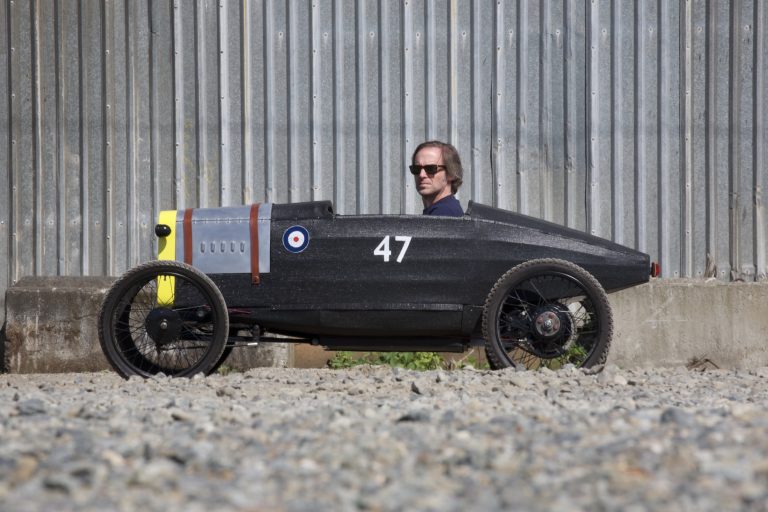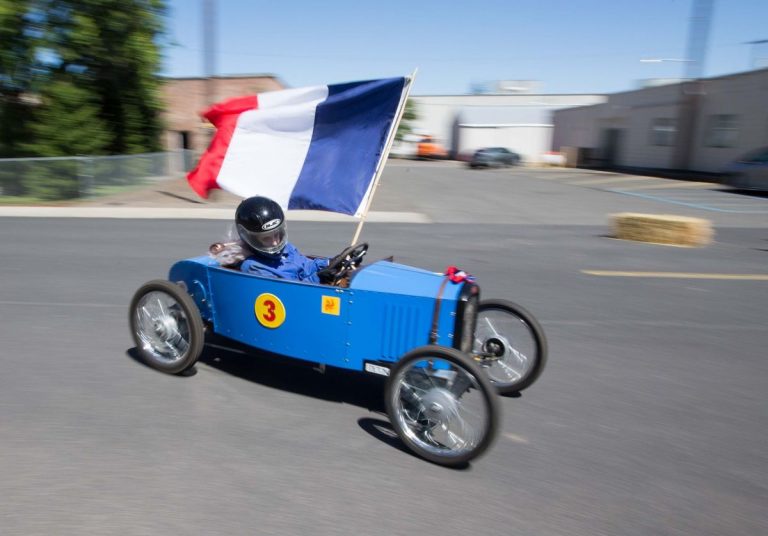F O U R
The 1920 Monroe (retired)Chassis number : 1307Running number : 4 Desperate for an escape from the fussy insanity of vintage car restoration, the eventual builder of the Monroe-Frontenac CK wondered if maybe an old go-kart would be fun to build. During his internet hunt for kart information he stumbled across the old Gittreville site and after a little investigating, and some head scratching, he was shocked to realize the amount
FRASER NASH
The story of the Frazer Nash build starts with Tuco calling myself and Pedro over to his shop to lend an extra hand as he built a “cyclekart”. We had never heard of them before, and once we saw what he was building, we were hooked. For a first time build, Pedro and I decided to keep it simple. The Frazer Nash Super Sports fit the bill. The variations of
CHRYSLER IMPERIAL
1932 Chrysler Imperial The 1932 Chrysler Imperial was chosen for its long bonnet, shrouding the impressive straight eight. The design goal was to accommodate a driver over 6’ in height while deemphasizing the Muppet effect. The steel channel frame was crafted using 1/8” steel plate for the for the flange and 1/16” plate for the web. While duplicating the strength of a conventional cyclekart steel tube frame the channel
MORGAN F2
BRITISH RACING GREEN The Morgan project was built by two high school students who had “grown up” with cyclekarts but had scant practical fabrication experience when they began. Plenty when they finished! Their Morgan was Gittreville’s first electric. The builders, both experienced racers, wanted to emphasize responsibility and pursue absolute efficiency with their build. The Morgan initially had an 800W motor and a 36V lead-acid (AGM) battery pack. In its
GP MERCEDES FLAT PACK
The 1914 French Grand Prix is reputed to be one of the greatest races of the twentieth century. After a Hiatus of 5 years Mercedes returned to the GP scene in 1914. Engines were now restricted to 4.5 litre for the first time so Mercedes drew on their Aero engine division to come up with a new high revving engine. A team of 5 Mercedes 18/100 turned up to what
LAGONDA V-12
The British race car with the Italian sounding name. The LAGONDA car company was founded in 1906 in Staines, England, by Wilbur Gunn, with the moniker chosen for the Shawnee name of his native Springfield, Ohio. In 1935 Lagonda shrewdly wooed W.O. Bentley away from prestigious Rolls Royce to design his now infamous V-12 which was launched in 1937. Later in 1939 the simply dubbed ‘V12’ was one of two
LE CAMION
Firstly, there was the car. The glorious green giants thundering along England’s country lanes; Sir Henry ‘Tim” Birkin was one of the famed “Bentley Boys”, and campaigned a privateer Bentley Four and a half liter monoposto. Over fourteen feet long, and weighing nearly two tons, the car was huge. There is a reason why Bugatti’s reported description of the Bentleys of the day as being “the world’s fastest trucks” has
BLOODY MARY
“This is the story of Bloody Mary. She was built in 1929 by two schoolboys who wanted to amuse themselves by dashing round a field, and what fun they had!” The opening lines of ‘Bloody Mary’, pamphlet #75 in the Classic Cars in Profile series. The story was written by acclaimed journalist, racer and co-builder of the car, John Bolster. Bloody Mary is without doubt the most famous “special” ever

AUSTIN SEVEN BOULOGNE
In 1923 Austin sent a team of three cars to contest the Voiturette Race in Boulogne, France. The Austin Seven Boulogne was part of The Great Austin Seven Build Off with fellow Austin Seven inspired cars: the BMW 35/15 PS-DA3 Wartburg, the Rosengart LR2 and Bruce McLaren’s Austin Seven racer. I have a lot of these profiles to personally compile having built ten cars either alone or as a team

PEUGEOT QUADRILETTE
The Gittreville story begins with the Peugeot Quadrilette. Her build began in 2008 when the Bush recession left her builder with extra time on his hands. With initial inspiration from the Stevensons, the Mighty Peugeot, as she has become known, took a slightly different tack from the Stevensons with much of that driven by the brutal conditions on her future playground at Gittreville. The Peugeot eschewed the plywood monocoque/foam/fiberglas Stevenson